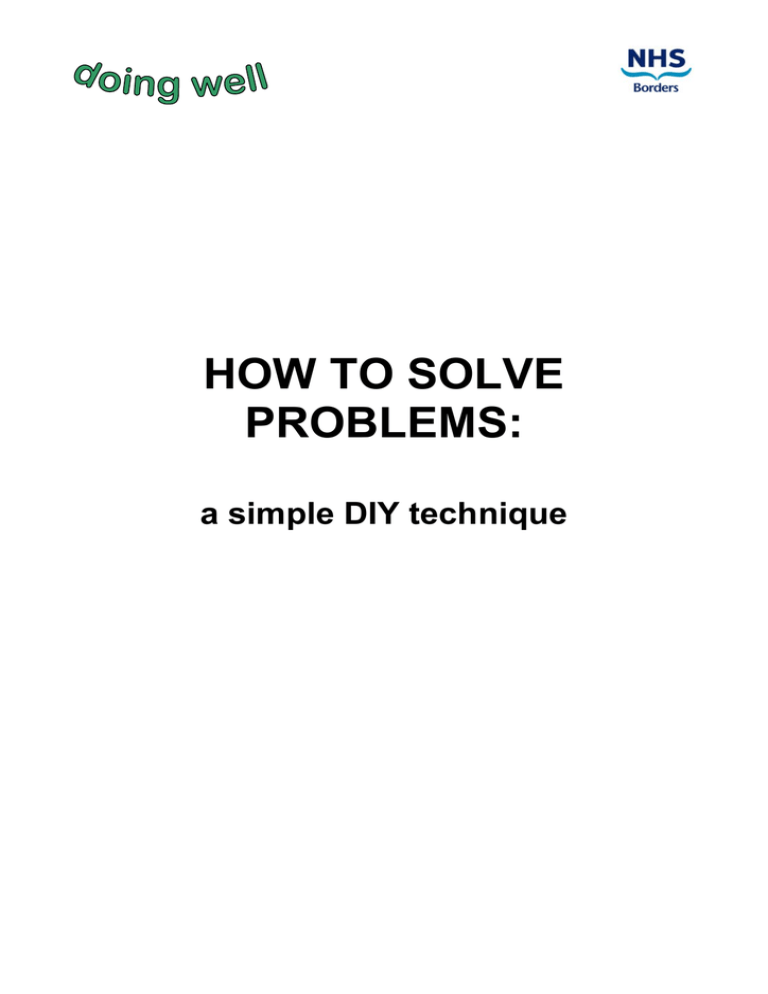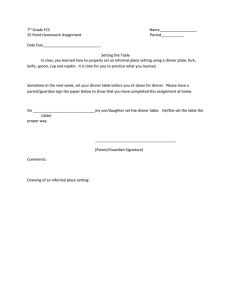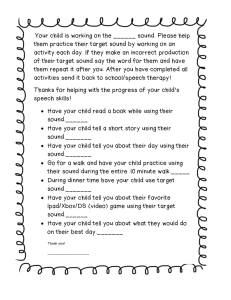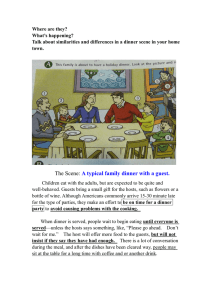How to Solve Problems: A Simple DIY Technique
advertisement

HOW TO SOLVE PROBLEMS: a simple DIY technique Problem Solving We all have problems in our day-to-day lives. At times these can cause anxiety, stress and distress. So what can be done? There is a way to help you solve your problems successfully. This is quite simply called 'problem solving'. There are five steps to problem solving. Step 1: Identify your problems Before you can solve a problem, you have to know what it is. What are the problems facing you at the moment? Some of them are probably quite large 'I have an eviction notice that comes up next week' while others are smaller 'I'm going to need lettuce if I want to make that salad tonight'. Others are somewhere in between 'There's a pile of mail and paperwork on my desk that I haven't looked at in over a month'. Make a list of your problems on the next page. Here are some tips: • don't spend too much time thinking about each problem. Just list each one and move on • you don't need to describe the problem completely • don't worry whether or not you think the problems can be solved • remember that you don't have to come up with the solution, just the problem • you don't have to finish your list in one sitting • you don't have to fill all the spaces Sometimes writing down all our problems can be quite scary. Try not to let the list you make worry you. Remind yourself that this is the first step towards solving your problems. Sometimes people find that when they start writing out their problem list it is not as long as they thought it would be. 2 List of problems z ........................................................................................................ z ........................................................................................................ z ........................................................................................................ z ........................................................................................................ z ........................................................................................................ z ........................................................................................................ z ........................................................................................................ z ........................................................................................................ z ........................................................................................................ Step 2: Pick a problem Now select one problem from the list you have made. It should be a problem that you really want to solve, and one that you can see may be possible to solve. Later on you can get to the ones that may seem more difficult. Which problem would you like to work on first? For example, a chosen problem could be: "I have friends coming for dinner and I have no food". This is a bit vague; it is helpful to state your problem as clearly as possible. This problem could be described more accurately as "I have friends coming for dinner and only have pasta and tinned fruit in the cupboard". Try writing the problem you have chosen as clearly as possible in the box below. MY PROBLEM IS: 3 Now answer the following questions: Have you solved similar problems in the past? If so, how did you do it? What strengths or skills did you use? ............................................................................................................ ............................................................................................................ ............................................................................................................ Are there any people who may be able to support you in your efforts to solve this problem? Ideally, these should not be people who will solve the problem for you, but people who can help you solve it yourself. Who are they? ............................................................................................................ ............................................................................................................ Next, think of the things you could do that might help. • try using brainstorming: write down as many actions as you can think of. • don't worry whether the actions will solve the problem completely. • don't worry if some of them seem silly. You are trying to get as many possible actions as you can. Then you will look at each one. List of possible actions: • • • • • • • get a takeaway take my friends out to dinner go to the shops now and serve them dinner a bit later ask them to bring something for dinner phone them and rearrange say the dog ate the dinner don't answer the door when they come and pretend I have forgotten altogether 4 Possible actions to help solve your problem ............................................................................................................ ............................................................................................................ ............................................................................................................ ............................................................................................................ ............................................................................................................ ............................................................................................................ ............................................................................................................ Step 3: Choose one of your solutions Now choose what seems to be the best action. There are no fixed rules for how to make this choice. The only rule is that you must choose one of the actions so that you can begin. Think about the good points and bad points for each, and then pick one. It should be an action that takes you at least part way towards solving your problem. Remember, if you try one action and find that it doesn't work, you can try another. Which action do you choose? ............................................................................................................ ............................................................................................................ Step 4: Make an action plan There aren't very many problems that you will solve completely with just one action. There might be many actions that will take you part of the way towards a solution. If you have a financial problem, for example, then your first action could be to gather the papers together so that you can look at them. Just gathering the paper won't solve the problem, but it will take you closer to a solution than you were before. The important thing is to get started on a solution. 5 Your plan of action should follow four rules that can be abbreviated as M.A.S.T. In other words: • Manageable. Even if you don't feel any better next week than you did last week (even if you feel a little worse), you could carry out your plan anyway. It's better to accomplish a goal that is small than to fail a big one. Here's a bad example: for my first time out, run a marathon. A better example: walk for ten minutes. • Action-oriented. Make a plan for what you will do, not how you will think or feel while you are doing it. You have some control over what you do, but you have less control over your emotions and thoughts. A bad example: spend a pleasant hour with my children. A better example: spend one hour with my children. • Specific. What you need to do should be very clear. A bad example: spend time with a friend. A better example: spend one hour with my friend Liz. • Time-limited. Your plan should take only a short time to carry out. Don't plan to change your lifestyle forever. A bad example: keep finances in order for the rest of my life. A better example: spend 20 minutes looking for income tax receipts. What's the plan, exactly? Action BY WHEN Carry out your plan by the time you set above. When you have carried out your plan, or when the deadline has passed go to Step 5. Step 5: Think about how it went, then move on 6 Now, think about how the plan worked out (even if the problem still hasn't been solved). What happened? What went well? What went badly? ............................................................................................................ ............................................................................................................ ............................................................................................................ ............................................................................................................ Use this experience to plan your next step. You have three main options: • Keep going. Example: spend another 20 minutes finding the papers. • Revise your goal and try again. Example: cleaning the garage for three hours was too difficult, so plan to work on it for just one hour instead. • Take a new approach. Perhaps your first effort has allowed you to find another way of handling the problem. Example: talking face to face with Aunt Sarah didn't work, so write her a letter instead. Based on your experience, what is the next step? ............................................................................................................ ............................................................................................................ ............................................................................................................ ............................................................................................................ ............................................................................................................ Keep working through the five steps. Keep a record of your efforts. Remind yourself of the progress you make. 7 Further help Books Butler, G and Hope, T (1995) Manage Your Mind Oxford ISBN: 0192623834 (Chapter 8: Problem-solving: a strategy for change) Williams, Chris (2002) Overcoming Depression: a five areas approach. Arnold. ISBN: 0340763833 (Workbook 2: Practical Problem Solving) This can be downloaded from the website, free of charge: www.calipso.co.uk/downloads/Workbooks/workbook2_problemsolving.pdf Booklets/leaflets available on the following: Anger Anxiety Bereavement Depression How to solve problems: a simple DIY technique Hyperventilation Panic (short version and long version) Relaxation Self-Harm Sleep Trauma Worry Copies of any of the above booklets are available free of charge from: Jenny Hastings, Self-Help & Toolkit Secretary, 12/14 Roxburgh Street, Galashiels TD1 1PF Tel: 01896 668831 email: Toolkit@borders.scot.nhs.uk S Black, J Hastings, M Henderson 2005 NHS Borders Developed with assistance from: The National Programme for Improving Mental Health and Well Being www.wellontheweb.net SH11.4 8


